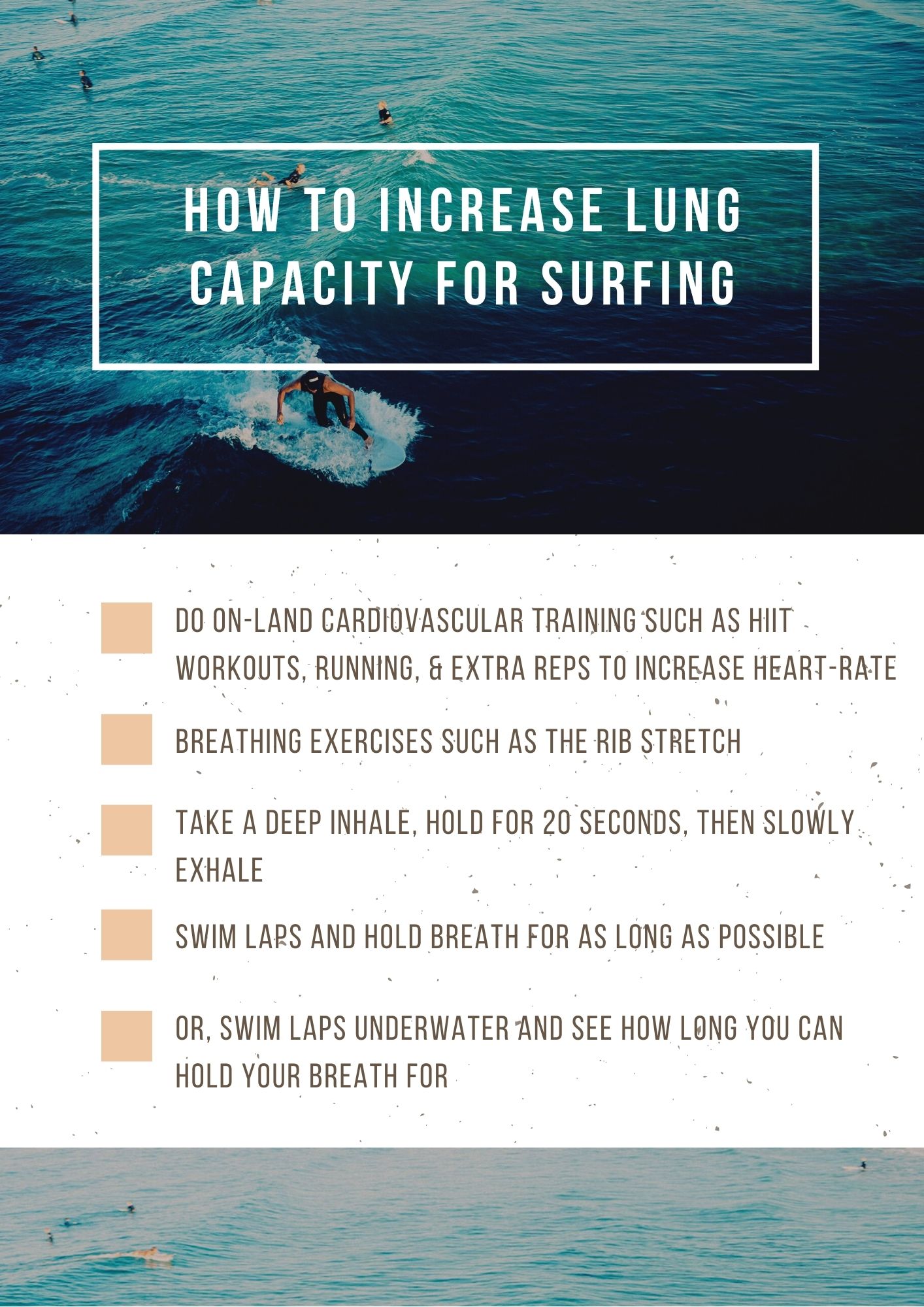How To Increase Lung Capacity For Surfing
Paige Rosenthal July 21st, 2020 Posted In: How-To Tags: Surfing
How To Increase Lung Capacity For Surfing
While you may have dreams of surfing huge wave sets, your lungs may not be on par with your ambition. Novice surfers might be surprised to find their underwater tolerance isn’t as strong as they expected once they’re hit with a few back-to-back wave sets. Like any new physical exertion, surfing requires training, especially when it comes to withstanding lengths of time underwater. Here’s how to increase lung capacity for surfing!
So, Why Is Lung Capacity So Important?
To put it in a word, safety. One challenge many surfers fear most out on the water is a hold-down, meaning you can’t reach the surface before the next wave lands on you. While this may only be the case with a seriously intense swell, even more, moderate waves can keep surfers underwater for uncomfortable amounts of time. With increased lung capacity, you can more easily stay calm if fighting for the surface under a wave or two.
Ultimately, this will decrease the risk of drowning, since you’ll obviously be able to hold your breath for longer. You’ll feel at home with holding your breath underwater and, again, know how to stay calm. Aside from the lack of air, panic can be just as dangerous.
Outside of safety, having a higher lung capacity will help you become a more skilled surfer. Athletes rely on strong breathing ability to sustain high-intensity physical activity, no matter their sport, and surfing is no different. Studies have shown that athletes overall have higher lung capacities than sedentary individuals. So, it makes sense, that in order to get your body ready to withstand those conditions, you need to train.
How Can You Increase Lung Capacity?
Fortunately, lung capacity can be increased, with a combination of training and patience. And, this starts by increasing cardiovascular activity. There are several on-land exercises that can help you to start before you hit the water. Whether performing high-intensity interval activity, putting yourself on a running regimen or hitting extra reps at the gym, whatever you can do to increase your heart rate will help your body become more efficient at oxygenating itself and ultimately help you hold your breath longer in the end.
There are also several breathing exercises to try that are also very helpful in increasing lung capacity. First is the Rib Stretch. Stand upright and exhale all of the air from your lungs. Slowly breathe in and expand your lungs to their maximum capacity. Then, hold the breath in for 20 seconds, or if 20 seconds isn’t doable, try what is comfortable for you at first. While counting, place both hands on your hips with thumbs facing front and pinkies touching the small of your back. Exhale the air slowly, and repeat.
Pushing out is another helpful exercise. Start with your feet flat on the ground, and with a straight posture, relax the knees and bend forward from the waist. Push the air out from your lungs, and then slowly return to an upright position. Inhale slowly, breathe in as much as possible, and hold your breath for 20 seconds. If 20 seconds is too long, however, cut it short to timing that’s reasonable for you. While counting, lift your arms over your head. As you exhale, relax and lower your arms slowly. Go through this cycle several times.
Breathing Exercises in the Water
As a surfer, you may be more inclined to want to increase your lung capacity in the water. There are several exercises in the water that will help get your body used to holding breath underwater and strengthening those lung functions while swimming. The biggest thing to focus on when increasing lung capacity while swimming is your breath. Start slowly and progress from there and use regular, controlled breathing patterns.
Then, when you’re ready, no-breathers are a great way to increase lung capacity. This means exactly what it sounds like. Swimming without taking a breath. Swim about 25 meters without taking a breath and gauge the difficulty. You may not be able to finish at first, but each time you’ll be able to push a little further until you finally finish. You’ll notice that with each lap, you went a little further. And, with that push, your lung capacity is increasing little by little each time.
Another way to practice breath control is to, of course, swim laps underwater. And see how many laps across the pool, or how far in the ocean you can go. Measure how many laps you can complete each day. And, the next day push for one lap, or a few strokes further. You’ll be amazed at how much longer you can hold your breath underwater after a few weeks of those kinds of exercises.
With a few exercises and a little patience, you can train your lungs to withstand more intense cardiovascular activity and strenuous underwater training to get them in shape to help you take on powerful swell without fear of any hold-downs.



With many wetsuits neoprene is between colored fabric.
Yes, Scott, you’re right. Most wetsuits are closed cell wetsuits. All of the wetsuits we currently carry are closed cell.
However, there are more and more wetsuit with other colors such as blue and green. You can find them in Amazon.
Thanks for sharing. You can also find them here on our website, and rest assured knowing that our wetsuits are of good quality and our customer support is top notch. Here’s a list of men’s wetsuits we currently have in other colors aside from black: https://www.wetsuitwearhouse.com/wetsuits/category/mens-wetsuits-general.html?InStockColors=Blue&InStockColors=Red&InStockColors=Green&Per_Page=24&Sort_By=bestsellers&suit_type=Fullsuits&suit_type=Shorty%20Springsuits